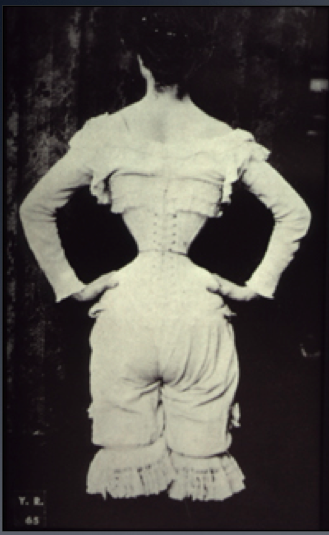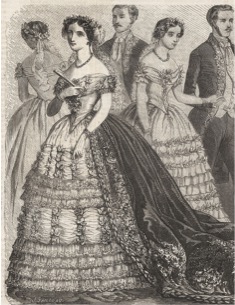|
Spoon Busk
The spoon busk was a specialised kind of busk—the rigid element of a corset placed at the centre front. As its name implies, it was shaped like a spoon, with the bottom part of the busk widening and taking a dished form. It was invented in 1879 by Joseph Beckel of New York City. The spoon busk allowed a greater reduction in waist size without producing a bulge of flesh at the bottom edge of the corset. This was a problem experienced when corsets with straight busks of even width were tightly laced: as the flesh of the abdomen was, essentially, squeezed out of place and appeared where there was no pressure. The wide, dished part of a spoon busk accommodated the abdomen, and at the same time compressed and controlled it. Corsets with spoon busks usually descended to a point lower than the level of the hips at the front. Despite the extra control given by spoon busks, they are not favoured by modern tightlacers as the bottom point of a spoon busk will dig in when a corset is ... [...More Info...] [...Related Items...] OR: [Wikipedia] [Google] [Baidu] |
Busk (corsetry)
A busk (also spelled busque) is a rigid element of a corset at the centre front of the garment. Two types exist, one- and two-part busks. Single-piece busks were used in " stays" and bodices from the sixteenth to early nineteenth centuries and were intended to keep the front of the corset or bodice straight and upright. They were typically made of wood, ivory, or bone slipped into a pocket and tied in place with a lace called the ''busk point''. These busks were often carved and decorated, or inscribed with messages, and were popular gifts from men to women during courtship. In the middle of the nineteenth century, a new form of busk appeared. It was made of two long pieces of steel, one with loops and the other with posts, that functioned in the same way as hook and eye fastenings or buttons on a garment. This made corsets considerably easier to put on and take off, as the laces did not have to be loosened as much as when the corset had to go over the wearer's head and should ... [...More Info...] [...Related Items...] OR: [Wikipedia] [Google] [Baidu] |
Corset
A corset is a support garment commonly worn to hold and train the torso into a desired shape, traditionally a smaller waist or larger bottom, for aesthetic or medical purposes (either for the duration of wearing it or with a more lasting effect), or support the breasts. Both men and women are known to wear corsets, though this item was for many years an integral part of women's wardrobes. Since the late 20th century, the fashion industry has borrowed the term "corset" to refer to tops which, to varying degrees, mimic the look of traditional corsets without acting as them. While these modern corsets and corset tops often feature lacing or boning, and generally imitate a historical style of corsets, they have very little, if any, effect on the shape of the wearer's body. Genuine corsets are usually made by a corsetmaker and are frequently fitted to the individual wearer. Etymology The word ''corset'' is a diminutive of the Old French word ''cors'' (meaning "body", and itsel ... [...More Info...] [...Related Items...] OR: [Wikipedia] [Google] [Baidu] |
New York City
New York, often called New York City or NYC, is the most populous city in the United States. With a 2020 population of 8,804,190 distributed over , New York City is also the most densely populated major city in the United States, and is more than twice as populous as second-place Los Angeles. New York City lies at the southern tip of New York State, and constitutes the geographical and demographic center of both the Northeast megalopolis and the New York metropolitan area, the largest metropolitan area in the world by urban landmass. With over 20.1 million people in its metropolitan statistical area and 23.5 million in its combined statistical area as of 2020, New York is one of the world's most populous megacities, and over 58 million people live within of the city. New York City is a global cultural, financial, entertainment, and media center with a significant influence on commerce, health care and life sciences, research, technology, educa ... [...More Info...] [...Related Items...] OR: [Wikipedia] [Google] [Baidu] |
Tightlacing
Tightlacing (also called corset training) is the practice of wearing a tightly-laced corset. It is done to achieve cosmetic modifications to the figure and posture or to experience the sensation of bodily restriction. History Corsets were first worn by members of both sexes of Minoans of Crete, but did not become popular again until the sixteenth century. They remained a feature of fashionable dress until the French Revolution, when corsets for women were designed mainly to turn the torso into a fashionable cylindrical shape, although they narrowed the waist as well. They had shoulder straps, ended at the waist, flattened the bust, and, in so doing, pushed the breasts up. The emphasis of the corset became less on the smallness of the waist than on the contrast between the rigid flatness of the bodice front and the curving tops of the breasts peeking over the top of the corset. At the end of the eighteenth century, the corset fell into decline. Fashion for women embraced the Em ... [...More Info...] [...Related Items...] OR: [Wikipedia] [Google] [Baidu] |
Galvanized Steel
Galvanization or galvanizing ( also spelled galvanisation or galvanising) is the process of applying a protective zinc coating to steel or iron, to prevent rusting. The most common method is hot-dip galvanizing, in which the parts are submerged in a bath of hot, molten zinc. Protective action The zinc coating, when intact, prevents corrosive substances from reaching the underlying iron. Additional electroplating such as a chromate conversion coating may be applied to provide further surface passivation to the substrate material. History and etymology The earliest known example of galvanized iron was encountered by Europeans on 17th-century Indian armour in the Royal Armouries Museum collection. The term "galvanized" continues to be used metaphorically of any stimulus which results in activity by a person or group of people. In modern usage, the term "galvanizing" has largely come to be associated with zinc coatings, to the exclusion of other metals. Galvanic paint, a ... [...More Info...] [...Related Items...] OR: [Wikipedia] [Google] [Baidu] |
Stainless Steel
Stainless steel is an alloy of iron that is resistant to rusting and corrosion. It contains at least 11% chromium and may contain elements such as carbon, other nonmetals and metals to obtain other desired properties. Stainless steel's resistance to corrosion results from the chromium, which forms a passive film that can protect the material and self-heal in the presence of oxygen. The alloy's properties, such as luster and resistance to corrosion, are useful in many applications. Stainless steel can be rolled into sheets, plates, bars, wire, and tubing. These can be used in cookware, cutlery, surgical instruments, major appliances, vehicles, construction material in large buildings, industrial equipment (e.g., in paper mills, chemical plants, water treatment), and storage tanks and tankers for chemicals and food products. The biological cleanability of stainless steel is superior to both aluminium and copper, having a biological cleanability comparable to glass. I ... [...More Info...] [...Related Items...] OR: [Wikipedia] [Google] [Baidu] |
Victorian Fashion
Victorian fashion consists of the various fashions and trends in British culture that emerged and developed in the United Kingdom and the British Empire throughout the Victorian era, roughly from the 1830s through the 1890s. The period saw many changes in fashion, including changes in styles, fashion technology and the methods of distribution. Various movement in architecture, literature, and the decorative and visual arts as well as a changing perception of gender roles also influenced fashion. Under Queen Victoria's reign, England enjoyed a period of growth along with technological advancement. Mass production of sewing machines in the 1850s as well as the advent of synthetic dyes introduced major changes in fashion. Clothing could be made more quickly and cheaply. Advancement in printing and proliferation of fashion magazines allowed the masses to participate in the evolving trends of high fashion, opening the market of mass consumption and advertising. By 1905, clothing ... [...More Info...] [...Related Items...] OR: [Wikipedia] [Google] [Baidu] |
Corsetry
A corsetmaker is a specialist tailor who makes corsets. Corsetmakers are frequently known by the French equivalent terms corsetier (male) and corsetière (female). Stay-maker is an obsolete name for a corsetmaker. The best corsetmakers are highly skilled tailors with a knowledge of anatomy that enables them to make well-fitting, long-lasting corsets. Corsetmakers who reproduce historical styles must be familiar with historical fashions and costumes that span centuries of history. Individual corsetmakers often favour a certain style, and frequently have differing theories and opinions about the physical impact and benefits of various corsets, thereby influencing their corset design and creation. Famous corsetmakers * Thomas Paine, one of the Founding Fathers of the United States. * Roxey Ann Caplin. *Catherine Allsop Griswold, a Connecticut corsetmaker who held thirty patents, the most of any woman in America at the time. [...More Info...] [...Related Items...] OR: [Wikipedia] [Google] [Baidu] |





